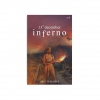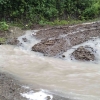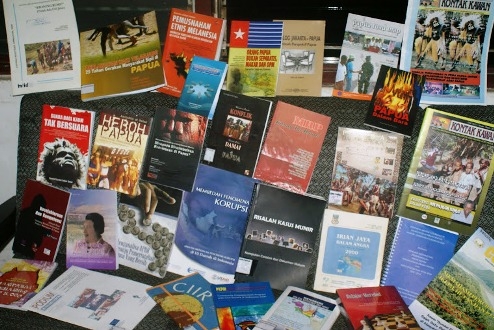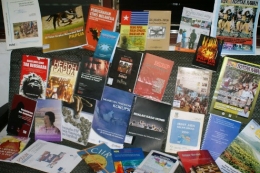Mencermati perkembangan gejolak Papua saat ini, ternyata tidak semata-mata dilatari kekecewaan para aktivis Papua merdeka atas ketertinggalan pembangunan di Tanah Papua dalam berbagai aspek. Buktinya, jika benar itu penyebabnya, mestinya dengan gencarnya perhatian Pemerintah Pusat melalui Otonomi Khusus dan pelibat-gandaan dana yang dikucurkan untuk membangun wilayah itu dalam 10 tahun terakhir, gejolak itu akan hilang, atau setidaknya berkurang.
Tapi faktanya? Tuntutan merdeka dan aksi-aksi gerilyawan bersenjata justru meningkat berbanding lurus dengan perhatian Negara dan besarnya dana yang dikucurkan.Gerakan para aktivis Papua saat ini tidak lagi hanya sekedar bermain di permukaan dengan aksi-aksi damai, long march, dan demo jalanan, tetapi telah merangsek ke “akar pohon”. Yakni, gerakan mengembalikan status politik wilayah Papua ke titik nol, lalu meminta REFERENDUM.
Untuk itu maka sejarah integrasi Papua ke dalam wilayah kedaulatan NKRI harus digugat. Karena menurut mereka, peristiwa politik internasional terkait integrasi Papua yang terjadi sejak tahun 1949 (Konverensi Meja Bundar), New York Agreement 1962, PEPERA 1969 hingga Sidang Umum PBB 19 November 1969 yang menghasilkan Resolusi No. 2504 adalah ilegal, dan karenanya harus digugat ke Mahkamah Internasional.
Untuk tujuan itu, tahun 2008 lalu mereka telah membentuk perkumpulan pengacara internasional (International Lawyer for West Papua / ILWP) yang bermarkas di London, menggalang dukungan parlemen dari berbagai negara (International Parliement for West Papua / IPWP) serta meningkatkan aktivitas gerakan di Tanah Papua melalui sayap politik (antara lain melalui pembentukan parlemen daerah) dan sayap militer (TPN-OPM).
Kita ingat, beberapa hari yang lalu di Pengadilan Negeri Jayapura, Forkorus Yaboisembut, terdakwa kasus makar yang dipilih menjadi ‘presiden negara federasi papua barat’ oleh sebuah forum yang mereka sebut konverensi rakyat papua-III, kepada wartawan yang meliput sidang itu mengatakan bahwa dirinya memiliki 35 pengacara dalam dan luar negeri. Di antaranya ada enam pengacara internasional yang bermarkas di Brussel. Tugas pengacara internasional itu adalah memberitahukan dan mendaftarkan negara Federal Republik Papua Barat (yang diproklamirkan oleh Forkorus dkk pada 19 Oktober 2011 itu) kePBB, serta menggugat aneksasi negeri Papua Barat ke Mahkamah Internasional. http://zonadamai.wordpress.com/2012/02/09/negara-papua-telah-didaftarkan-ke-pbb/
Kita tidak tahu dokumen sejarah mana yang akan mereka gunakan untuk mendukung dalil hukum mereka di Mahkamah Internasional kelak. Namun sebagai bangsa, kita percaya bahwa Pemerintah Negeri ini dengan semua perangkat yang dimilikinya, tidak akan tinggal diam untuk menjaga KEDAULATAN wilayah NKRI dari Sabang sampai Merauke, dari Talaud sampau ke Rote. Bagi kita, bergabungnya wilayah Papua ke dalam NKRI adalah melalui proses integrasi yang demokratis serta sudah sesuai mekanisme hukum internasional yang berlaku saat itu. Dan itu sama sekali jauh berbeda dengan apa yang mereka tuduhkan sebagai aneksasi.
Agar kita tidak terjebak dalam skenario “bualan politik” para aktivis Papua, berikut ini saya bagikan dokumen resmi Perserikatan Bangsa-Bangsa tentang sejarah integrasi (bukan sejarah aneksasi) Papua ke dalam NKRI, yang saya copas dari situs resmi PBB : http://www.un.org/en/peacekeeping/missions/past/unsfbackgr.html
Mengingat panjangnya dokumen tersebut, saya akan turunkan secara bertahap sebagai bahan referensi para Kompasianer, sekaligus untuk menjaga semangat nasionalisme kita sebagai sebuah bangsa yang sudah 67 tahun berdaulat yang bernama Republik Indonesia.
Historical background

The status of the territory was still being disputed when Indonesia brought the matter before the United Nations in 1954. Indonesia claimed that the territory rightfully belonged to it and should be freed from Dutch colonial rule. The Netherlands maintained that the Papuans of West New Guinea were not Indonesians and therefore should be allowed to decide their own future when they were ready to do so. The future of the territory was discussed at the General Assembly's regular sessions from 1954 to 1957 and at the 1961 session, but no resolutions on it were adopted.
In December 1961, when increasing rancour between the Indonesian and Dutch Governments made the prospect of a negotiated settlement even more elusive, Secretary-General U Thant, who had been appointed Acting Secretary-General following the death of Secretary-General Dag Hammarskjöld, undertook to resolve the dispute through his good offices. Consulting with the Indonesian and Dutch Permanent Representatives to the United Nations, he suggested that informal talks take place between the parties in the presence of former United States Ambassador Ellsworth Bunker, who would act as the Secretary-General's representative. The parties agreed, and talks were begun in early 1962.
A sharpening of tension between the two Governments occurred shortly thereafter, however, when Indonesia landed paratroops in West New Guinea. The Netherlands charged that the landings constituted an act of aggression, but Indonesia refuted this on the grounds that "Indonesians who have entered and who in future will continue to enter West Irian are Indonesian nationals who move into Indonesia's own territory now dominated by the Dutch by force". Secretary-General U Thant urged restraint by both parties but declined a Dutch request to send United Nations observers to the scene, noting that such action could only be considered if both Governments made the request. Further incidents were reported by the Netherlands during the first months of 1962, and there were intermittent lulls in the progress of Ambassador Bunker's talks.
The Acting Secretary-General was at last able to announce, on 31 July 1962, that a preliminary agreement had been reached, and that official negotiations were to take place under his auspices. The final negotiations were held at United Nations Headquarters under the chairmanship of the Secretary-General, with Ambassador Bunker continuing to act as mediator. An agreement was signed at New York by Indonesia and the Netherlands on 15 August 1962. Ratification instruments were exchanged between the two countries on 20 September 1962 and, the next day, the General Assembly took note of the agreement in resolution 1752 (XVII) of the same date, authorizing the Secretary-General to carry out the tasks entrusted to him therein.
The agreement provided for the administration of West New Guinea (West Irian) to be transferred by the Netherlands to a United Nations Temporary Executive Authority (UNTEA), to be headed by a United Nations Administrator who would be acceptable to both parties and who would be appointed by the Secretary-General. Under the Secretary-General's jurisdiction, UNTEA would have full authority after 1 October 1962 to administer the territory, to maintain law and order, to protect the rights of the inhabitants and to ensure uninterrupted, normal services until 1 May 1963, when the administration of the territory was to be transferred to Indonesia.
The agreement also stipulated that the Secretary-General would provide a United Nations Security Force (UNSF) to assist UNTEA with as many troops as the United Nations Administrator deemed necessary. In "related understandings" to the main agreement, it was established that United Nations personnel would observe the implementation of the ceasefire that was to become effective before UNTEA assumed authority. The United Nations was therefore entrusted with a dual peacekeeping role in addition to its administrative responsibilities as the executive authority.
Arranging a ceasefire
To pave the way for the arrival in West Irian of UNTEA and UNSF, a ceasefire between Indonesian and Netherlands forces had to be enforced. The memorandum of understanding concerning the ceasefire C presented on 15 August 1962 in a note to the Acting Secretary-General from the representatives of Indonesia and the Netherlands C requested that the Secretary-General undertake immediately some of the functions outlined in the main agreement, so as to effect a cessation of hostilities as soon as possible. Such action would constitute an "extraordinary measure", because the General Assembly would not be voting on the establishment of UNTEA and UNSF until it convened in late September.
The Secretary-General responded promptly, stating that he was prepared to undertake the responsibilities mentioned in the note. The memorandum on the cessation of hostilities specified that the Secretary-General would assign United Nations personnel to perform certain tasks, including: observing the ceasefire; protecting the security of Dutch and Indonesian forces; restoring the situation in the event of breaches of the ceasefire; assisting in informing Indonesian troops in the jungle of the existence of the ceasefire; and providing a non-military supply line to Indonesian troops.
Although there was no explicit reference to military observers in the memorandum, the Secretary-General selected them to perform these tasks. Furthermore, he agreed to dispatch them without the prior authorization of the General Assembly or the Security Council, a step never before taken by a Secretary-General. Reference was made in the memorandum to UNSF and its law-and-order maintenance role, with the implication that the Secretary-General should address this responsibility with all possible speed.
The Secretary-General appointed Brigadier-General (later Major-General) Indar Jit Rikhye, his Military Adviser, to head the military observer team that was to supervise all arrangements for the ceasefire. Six Member States (Brazil, Ceylon, India, Ireland, Nigeria and Sweden) agreed to provide 21 observers for this purpose. They were drawn from troops of these nations then serving either in the United Nations Emergency Force or the United Nations Operation in the Congo.
The observer force was assembled in West Irian within days of the signing of the agreement at United Nations Headquarters. The observers were informed at that time that the Netherlands military command had proclaimed a ceasefire as of 0001 GMT on 18 August 1962, and had ordered its ground forces to concentrate in the main garrison towns, although air and naval forces continued to patrol the territory. After a visit to Djakarta by General Rikhye, contacts were established with the Indonesian troops in the jungle. In this connection, frequent radio broadcasts on both the Netherlands-owned and Indonesian stations told the troops that hostilities had ceased. Printed pamphlets carrying the ceasefire message were dropped from airplanes over the jungle.
Besides supervising the ceasefire, the United Nations observers helped resupply the Indonesian troops with food and medicines and helped them regroup in selected places. The effort was successful owing to the full cooperation of the Indonesian and Netherlands authorities. Aerial support was given by the Thirteenth United States Task Force for the Far East and the Royal Canadian Air Force. Most of the emergency supplies were provided by the Netherlands military command, which also treated any Indonesian troops who were seriously ill. United Nations aircraft landed supplies in four staging areas: Sorong, Fakfak, Kaimana and Merauke.
By 21 September 1962, General Rikhye was able to report that all Indonesian forces in West Irian had been located and concentrated, that resupply had been assured and that over 500 Indonesian political detainees had been repatriated in accordance with the memorandum. The observers' mandate had thus been fulfilled and all actions concerning the cessation of hostilities had been completed without incident.
(Bersambung)



![Mengurangi Ketergantungan Beras [Bagian 1]](https://assets-a2.kompasiana.com/items/album/2024/03/18/beras-bulog-65f72a2ede948f078b77eeb2.jpg?t=t&v=100&x=100&info=meta_related)








